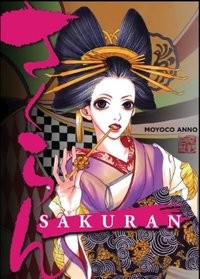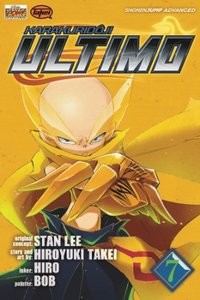RIGHT TURN ONLY!!
Sakuran Saku
by Carlo Santos,

A new TV season of Hetalia? Ah, so the franchise still has legs! And after seeing all the countries in the Olympics Opening Ceremonies, it makes me realize how much untapped potential the series has ...
ANGEL PARA BELLUM

Vol. 1
(by Kent Minami and Nozomu Tamaki, Seven Seas, $11.99)
FROM THE BACK COVER:
"A war between heaven and hell is brewing and only a young man named Mitsuru holds the key to prevent it. Yet Mitsuru is unaware of his secret birthright and his role in the battle between angels and demons. All he knows is that his family is dead and Kyrie, the kindly woman who cared for him in his time of mourning, is not what she seems. Now, with demon attackers seeking to destroy him at every turn, his only protection is two beautiful gun-wielding angels who kick ass like nobody's business."
EVIDENCE FOR:
For pure girls-with-guns action, it doesn't get much more intense than this. Angel Para Bellum dives right in with a kidnapping, a gunfight, and a monstrous demon transformation before the first chapter is even over. What's more, it isn't afraid to venture into Judeo-Christian mysticism—famous angels and demons are part of the series' lore, as well as apocalyptic events. The result is a world much deeper than the usual "some gang versus some other gang" setup that usually comes with the genre. What gang war could possibly be more epic than the one between God and Satan? The breakneck pacing and sense of urgency shines best in the middle chapters, where an entire horde of demons comes after Mitsuru and his escape is aided by a host of five angels. The entire sequence is one eye-popping set piece after another: white-knuckled chase scenes, bullets and bodies strewn everywhere, and a page-spanning finale of Biblical proportions. Artist Nozomu Tamaki has a natural flair for sketching out energetic, high-impact scenes, which could cost millions to produce in Hollywood—but is far more affordable (and just as imaginative) in paper and ink.
EVIDENCE AGAINST:
Normally I can overlook fanservice as just another aspect of manly-man entertainment, but here it's distracting to the point of stupidity. It's one thing to have a female character who doesn't mind going topless, but when she's flaunting her bare chest in almost every scene, striking porn-star poses, and basically doing everything short of twisting her spine 180 degrees, the artwork has clearly become a self-indulgent embarrassment that no longer serves the story. What's more, the art isn't even that good in the first place—bodily proportions and facial features are never quite exactly "on," and the overall style has a stiff, sterile appearance that comes from too much computer touch-up. The story, meanwhile, suffers from the usual shortcomings of the genre: all this mystical name-dropping sounds like an attempt to sound intriguing without any substance to back it up, while the villains discuss their plans in vague, ominous terms. The main characters' situation also seems like made-up nonsense: the angels are here to protect Mitsuru because he's "the boy of destiny," just like ... you know, every other fantasy-action protagonist ever. So much for originality.
FINAL VERDICT:
The action is fun, and the premise has potential, but the weak storyline and shaky artwork spells a C for the series so far.
BAKUMAN

Vol. 13
(by Tsugumi Ohba and Takeshi Obata, Viz Media, $9.99)
FROM THE BACK COVER:
"Average student Moritaka Mashiro enjoys drawing for fun. When his classmate and aspiring writer Akito Takagi discovers his talent, he begs Moritaka to team up with him as a manga-creating duo. But what exactly does it take to make it in the manga-publishing world?
After being told their current series Perfect Crime Party will not be turned into an anime, Moritaka and Akito start planning on ways to create a second series. Their best chance might be to do well in a new contest where they will compete with their rivals over who can create the best romance story!"
EVIDENCE FOR:
Just when it seems that Bakuman has fallen into a predictable cycle of manga contests, deadlines, and series proposals ... here comes another brilliant, out-of-left-field surprise. This time it's perpetually lazy (and lovesick) manga-ka Hiramaru pulling out all the stops to win the heart of fellow artist Aoki, in a chapter so exhilarating that it's basically a pure, feel-good burst of energy. But the events leading up to that are just as compelling, if a little slower-paced: everyone's trying to think up romantic storylines for a one-shot contest, and seeing the different approaches to a single genre is another illuminating look at the creative process (along with the discovery that even geniuses have weaknesses). The whole contest cleverly foreshadows the climactic Hiramaru chapter: after getting romance on everyone's minds, what better way to cap it off than a crazy guy acting out all the great romantic clichés? Of course, this craziness is made possible by Obata's dynamic art, where the characters strike zany, larger-than-life poses in their moments of passion. Even a wacky reaction face can spice up a page. The detailed backgrounds and delicate lines also continue to impress, making every panel look precise and polished.
EVIDENCE AGAINST:
One brilliant chapter (and an attention-grabbing cliffhanger in the one after it) can't save this volume's incredibly tedious first half. During the whole romance one-shot contest, there's also a subplot about Takagi breaking away to collaborate with art assistant Shun, while Mashiro tries to draft an entire story on his own. This supposed rift between the two is, quite frankly, mind-numbing. They just keep arguing the same points over and over—"My first priority is toward PCP!" "We've got to work together!" "No, I've got figure this out myself!"—and it doesn't help that Takagi's wife Kaya has to keep chiming in with her neurotic worries. In a series where too much dialogue is already the biggest problem, throwing in all this back-and-forth bickering makes it even worse. Although Mashiro and Takagi eventually resolve their differences, the feeling afterward is one of exasperation, rather than relief that the fight is over. And because of all this arguing, the volume doesn't have as much room for educational, inside-industry content, aside from the overview on different styles of romance. At least the cliffhanger finale promises something new for Volume 13 ...
FINAL VERDICT:
Starts off incredibly tedious with the Mashiro/Takagi separation, but eventually leads up to that brilliantly executed Hiramaru chapter. Overall, the series' ups and downs and light humor still earn it a B.
THE DISAPPEARANCE OF NAGATO YUKI-CHAN

Vol. 1
(by Nagaru Tanigawa and Puyo, Yen Press, $11.99)
FROM THE BACK COVER:
"Yuki Nagato, the shy president of the literature club, has never been very sure of herself around other people. But around Kyon, the only boy in the tiny, three-person club, Yuki finds herself faltering even more than usual. For Kyon, and for her precious club, Yuki must find her confidence and let her true personality shine! Enjoy taking a fresh look at your favorite characters in this brand-new story set in the world of The Disappearance of Haruhi Suzumiya!"
EVIDENCE FOR:
If the original Haruhi Suzumiya is the work of a straight-A math-and-physics honor student, this spinoff is a sweet, dreamy masterpiece penned by a kid in the drama and poetry club. The Disappearance of Yuki-chan explores emotional corners that "the real Haruhi" never got to: the idea of a shy, endearing Yuki Nagato (as opposed to the cold, enigmatic one everyone's familiar with), a Kyon who plays the quiet, observant everyman instead of trying to crack sarcastic one-liners constantly, and best of all, a budding romance between the two. The Christmas party chapter midway through is really where this story comes into its own, with deliberate pacing and warm-hearted sentiment. Then it boldly jumps to a flashback that opens up Yuki's character even further—while also connecting to the main Disappearance of Haruhi plotline. So don't let anyone say it's a shallow spinoff of the original, because this one definitely has its own story to tell. The simple, rectangular layouts and almost-gag-manga art style are a perfect fit for the story's mood—a slice-of-life chronicle with comedic outbursts (got to love those super-deformed faces) and just a hint of mystery.
EVIDENCE AGAINST:
Don't get too excited about this series—it may have more substance than the Haruhi-chan shorts, but it's still a bargain-basement knockoff compared to the brand-name Haruhi works. As the name suggests, this one is pretty much made for Yuki fans (not to mention Kyon/Yuki shippers), treating the rest of the supporting cast as bland, plastic figures who are just there to participate in mindless school hijinks. That's right, the first few chapters are inconsequential comedy episodes that are hardly worthy of such a famous franchise. A quest to buy a Christmas turkey? A Yuki/Mikuru skills contest in the shopping district? This is the kind of drivel that fans write and read online for free. Still, the greatest injustice to the Haruhi name may be the sloppy art. Just look at the character designs, where Yuki resembles a geeky little boy more than a shy, endearing girl, and side characters Asakura and Tsuruya are drawn so alike that no one can tell who's who. The backgrounds are either lazy shades of screentone or completely absent, and the overall level of detail looks incomplete. Yup, definitely a cheap knockoff.
FINAL VERDICT:
This one seriously needs to improve in the art department, but the story develops well enough in the second half that Haruhi fans can still enjoy it to the tune of a B-.
SAKURAN

(by Moyoco Anno, Vertical, $16.95)
FROM THE BACK COVER:
"In Sakuran, Moyoco Anno lifts the veil on life in the Edo-period pleasure quarter, Yoshiwara. The story follows Kiyoha, sold into a brothel as a child and forced to work as a maid and her rise to prominence as one of the top-ranking courtesans in Yoshiwara. The allure of the 'flower and willow world' as it was called by artists in the day is underscored with the very real tragedy, heartbreak and difficult lives led by those seemingly glamorous courtesans. Will Kiyoha's fox-like wiles give her a chance to break free of her gilded cage? Or will her fighting spirit ruin her chances of ever escaping the brothel?"
EVIDENCE FOR:
The mature themes of Sakuran may be the furthest thing from Moyoco Anno's fantasy romp Sugar Sugar Rune, but they do share one thing in common: a charismatic, rebellious heroine who does things her way. Kiyoha hates the brothel system, she'd do anything to get out ... and yet she stays and learns how to take advantage of it. If conflict is the driving force behind all good stories, it doesn't get much better than this—the war rages within Kiyoha, between the true intentions of her heart and the lies she whispers into her clients' ears. The overall portrayal of feudal-era Japan also feels more lively and real than other historical works: the characters curse and chatter casually, they get into petty fights, and fall in and out of love, which in Kiyoha's case is the dramatic linchpin of the story. Anno's artwork also puts a fresh spin on the genre, with doe-eyed characters, crisp lines, and busy panels that give the impression of a story always in motion. Although the art is detailed and well-researched, it also gives off an aura of modern irreverence—a perfect fit for a heroine who dares to buck the trend.
EVIDENCE AGAINST:
While some readers may like Sakuran for being compact enough to fit in a single 300-page volume, I see it as a missed opportunity for something greater. The focus rests entirely on one character, who climbs the career path straight up, hits a life-changing roadblock, then overcomes it. End of story. What about the stories of the people Kiyoha meets along the way? What about the girls who aren't as smart or bold as her, and have to find another way to make a living? This volume offers a glimpse into a fascinating world, but closes up before we ever get a chance to peek around the corners. What's more, the rushed pacing makes some segments feel underdeveloped—like when Kiyoha falls in love with a working-class guy, or when she makes the transition from apprentice to full-fledged courtesan. With these 20-page chapters, it's like the stages of her life are being told in bullet points instead of flowing naturally. The lively artwork can also be its own worst enemy at times, as some panels are so crowded with detail that the focal point is lost.
FINAL VERDICT:
Its greatest strength is a compelling lead character and unique artwork, but the one-and-done nature of the story holds it back from masterpiece status. Still, it's good enough for a B+.
ULTIMO

Vol. 7
(by Hiroyuki Takei, original concept by Stan Lee, Viz Media, $9.99)
FROM THE BACK COVER:
"Ultimo and Vice are Karakuri Dôji, the mechanical embodiment of pure good and pure evil, devoid of human emotions that can cloud one's judgment. Their purpose: to battle to the death to prove once and for all whether good or evil is the most powerful force in the universe.
As Vice and his cohorts gather to plan their strike against Ultimo, puppet master Dunstan tells them he's planned the Hundred Machine Funeral as an epic battle in which fighters for good and for evil must convince one another to switch sides! Meanwhile, Yamato's crush Sayama discovers that she too was involved in Yamato's heroic struggle in a past life..."
EVIDENCE FOR:
So, you want to stage the ultimate battle between Good and Evil without it turning into a total cliché? How about letting Stan Lee—sorry, "Dunstan"—rewrite the rules of the game? Yes, the biggest surprise in this volume of Ultimo is the revised terms of battle, which promise to take the series in a new direction. Instead of Ultimo and Vice's factions fighting to the death, they have to convert the enemy, like a cosmic game of Othello. Of course, it wouldn't be Ultimo if these new rules weren't presented in spectacular fashion: Dunstan flamboyantly reveals his true powers, while Ultimo and Vice transform into their top fighting modes. The visual uniqueness really stands out here, as spiky lines and sweeping curves meet in a collision of sci-fi and sorcery. Equally impressive is how all of the character designs are distinct from each other, even with so many combatants. But it's not all just mindless action: some down-to-earth drama also balances things out, with a flashback into Yamoto and Ultimo's past, plus some unnerving moments as Yamato tries to resume his daily life—which obviously will never be the same.
EVIDENCE AGAINST:
With all the bombastic events, it's as if this volume of Ultimo is desperately trying to say something important ... when it really has nothing to say. It's a fresh story arc, so Ultimo and Vice can't actually fight to the death just yet—instead, they just show up in full mecha-battle gear and dramatically threaten each other. But an even bigger problem is how arbitrary the new battle rules seem: now you just have to flip the good/evil switch on the enemy, so the series could drag on, back and forth, for dozens of volumes. Of course, readers may end up jumping up ship far sooner, considering all the confusing subplots and extra characters. It's hard enough keeping track of Yamato and his immediate circle, plus their feudal-era selves—yet the story also insists on jumping back and forth between what other dôji masters are up to. With that unfocused approach, the plot's going to be a complete mess in no time. Meanwhile, the artwork's already a mess anyway, as the battle outfits (or mecha suits, or something) are often too elaborate to make any sense of. It may look cool, but who on earth is fighting?
FINAL VERDICT:
Aside from the new rules of battle, does this volume actually accomplish anything? Too much pointless plot-churning, and too little actual progress, earn this a C-.

KONO S WO, MI YO! (Take A Look At This S!)

Vol. 1
(by Taku Kitazaki, Shogakukan, ¥540)
SUMMARY:
In the 22 years of his life, Rin has always been self-conscious of the strangely-shaped birthmark on his butt. In fact, it's the reason he's never been in a physical relationship with a woman—he's too scared of letting anyone see him naked. But one night, after an accident, Rin ends up in a hospital room where a nurse catches a glimpse of the birthmark ... and is suddenly overcome by an insatiable lust for Rin! Somehow, Rin's most embarrassing bodily feature has the power to drive women wild, but only if he has the courage to expose himself to them. Can he use that to win over Chizuru, the older woman he's long been in love with, or will Rin's self-consciousness stop him in his tracks?
EVIDENCE FOR:
The great thing about Kono S wo, Mi yo! is that it isn't really about having a magical birthmark on one's butt. Beneath the kooky premise is a surprisingly in-depth romance—one where the characters are young adults who actually think things over, and have useful things to say about the ups and downs of love. Rin's internal monologues and flights of the imagination are a dead-accurate portrayal of the insecurities young men face today: the pressure to be sexual conquerors, the fear of romantic rejection (which, let's face it, never really goes away), and trying to overcome childhood neuroses on the way to maturity. The relationship between Rin and 30-year-old love interest Chizuru has genuine depth, with flashbacks into their childhood and teenage years to fill out the story. But the series never lets itself wallow too long in such seriousness—there's always another silly, perverted gag lurking around the corner, and it's that odd contrast that keeps the story interesting. The clean, straightforward layouts on each page also allow the visuals to flow naturally, along with distinctive character designs that make it easy to keep track of Rin and friends.
EVIDENCE AGAINST:
Like many male-targeted romance series, this one lays it on thick with crass, near-pornographic fanservice at the start ... but thankfully dials it down as the story develops. However, that approach is dangerously misleading in this case—the change in tone from the raunchy opening chapters to the heartfelt ending of Volume 1 is so extreme that it feels like two different stories. Were you hoping to go on a comical joyride where Rin tries to bed as many women as possible? While delving into a supernatural investigation of why his birthmark is able to do what it does? Sorry, change of plans, let's wade through all his relationship problems instead! Rin's desperate, self-deprecating attitude can get annoying pretty quickly—especially for those who dislike the weak-willed "herbivorous males" so common in this genre. Meanwhile, the shoddy artwork in the first chapter is another turn-off, and the character designs—polished as they are—look like they could have been referenced straight from a how-to manual. Backgrounds also become predictably dull in the later chapters as the focus turns toward conversation instead of action.
FINAL VERDICT:
It starts out weird, that's for sure—but those who are willing to invest in the main characters' relationship will find a story more satisfying than the initial premise suggests.

Who doesn't love a little wilderness-survival adventure? This week's contributor, Michael Gandara, seems pretty cool with it—as you can see in his review below.
Don't forget, everyone's opinions are equally welcome here, so feel free to send in your own review on whichever manga strikes your fancy!
CAGE OF EDEN

Vols. 1-5
(by Yoshinobu Yamada, Kodansha Comics, $10.99 ea.)
At first glance, it starts off typical with your "average high school boy" and "childhood friend" clichés that will most likely never die off. And then, everything gets turned upside down. The average high school boy in question, Akira Sengoku, is our hot-blooded but well intentioned protagonist with a perverted streak to put the girls at bay with the exception of his good friend Rion Akagami. With no law and order, stuck on a faraway island with little to no supplies, the island is turned into a "Lord of the Flies" scenario: survival of the fittest, charting your own path and making your own rules without regard for others.
The thing that makes Cage of Eden a really great read is the art. What I'm talking about is the designs of the extinct animals: they look terrifyingly real. The driving message about this series is fear, that these supposedly extinct creatures are still alive and raring to find fresh blood, and Yoshinobu Yamada's designs totally instill both a clear understanding of these beings and how to draw them in a way that's realistic and as terrifying as can be. Akira is also a pretty good leading character; sure, his undying trust in friendship has caused a lot of eyebrow raising amongst his group and he exhibits the same perverted instincts any high school boy would, but these five volumes really establish how believable his leadership talents are. In fact, one character in Volume 5 said it best: "In a world like this, where even our teachers betray us, a stupidly honest person like [Akira] is the most dependable."
I'm okay with some fanservice just as is, even better if there's *gasp* a reason for it, but Cage of Eden's fanservice can be frustrating at times. There's also Yarai: Now, I think Yarai is a character I want to see more of and he remains a fascinating one, but this guy usually comes in and magically fixes everything. He's pretty level-headed and very smart but you get the feeling he always just happens to be around when Akira and the group are in trouble. In Volume 5, Yarai comes at the right time and finds out a way to save everyone inside the cave. I'd like a chapter or two that focuses on Yarai, because his come and go nature doesn't sit well with me not when there's a lot about him that's interesting and worth going in depth on.
Overall, I think I found a manga worth continuing. Cage of Eden has some flaws it could work on, some that are harder to touch upon, but it always leaves you wanting more, and that's something any anime or manga needs to have to keep viewer/reader interest.
Is there a hidden gem of manga you'd like to reveal to the world? Is there a piece of garbage that deserves to be bashed in public? Or is there a title that didn't get a fair grade here, and you want to set the record straight?
Now's YOUR chance to be the reviewer! Write a review of about 300-400 words (a little more or less is fine) and include:
- Your name
- Title of manga (and volume no., if applicable)
- Author/Artist
- Publisher
- Briefly describe the story, then explain why this manga is great, terrible, or in between. Be objective, but also be entertaining.
Then send it in to rtoreaders (at) gmail (dot) com (plain text format preferred). One review will be selected out of all the submissions and will be published in the next column. All types of manga and manga-inspired comickry are accepted, from past and present, from Japan and beyond—what matters is that it's the Reader's Choice! NOTE: Submissions may be edited for formatting and grammar.
discuss this in the forum (26 posts) |